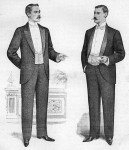A change of clothes – Tzav
 The kohen had to change his clothes from time to time, depending on the nature of the task ahead.
The kohen had to change his clothes from time to time, depending on the nature of the task ahead.
Sometimes they were utilitarian garments, sometimes impressive regalia (Lev. 6:4).
The rabbis say that this is the origin of the practice of changing into one’s best apparel to mark Shabbat or festivals.
In England they used to speak of “Sunday best”, which comes from the same source.
How you look suggests what your priorities are: as the saying goes, “Clothes make the man”.
I had a synagogue president once who allocated synagogal honours on the basis of whether the recipient was properly dressed: “We’ll give him an Aliyah”, my president used to say; “He looks tidy enough!”
The president himself wore the official garb that was customary for congregational honorary officers in the London United Synagogue in those days – black jacket, striped trousers, top hat. He was probably more concerned with decorum than devotion, but in the end it worked out in the way in which it should. An important occasion had to be fittingly marked.
Of course the customs vary according to where you are. In Israel hardly anyone wears a suit and tie on Shabbat and festivals (apart from me – the customs of a lifetime are so hard to abandon), but a clean white shirt, open-necked of course, is taken for granted.
Not only in regard to the person but the house too. Shabbat and chaggim are the time for everything to look festive.



